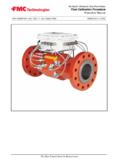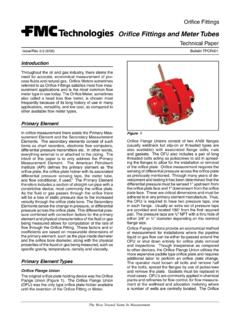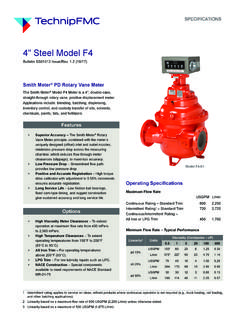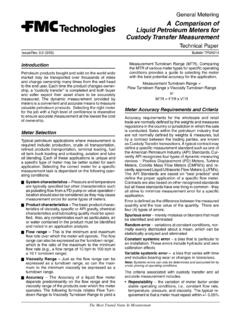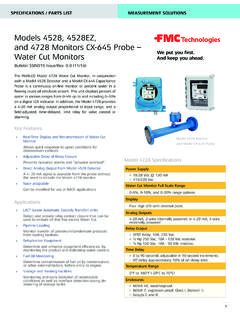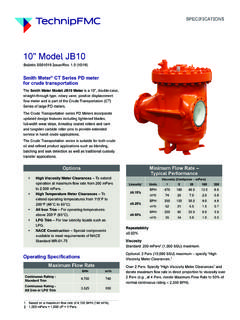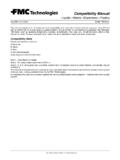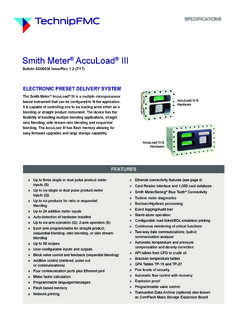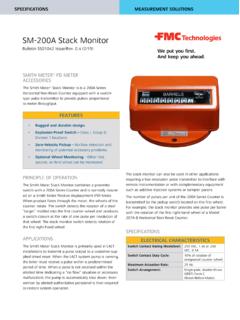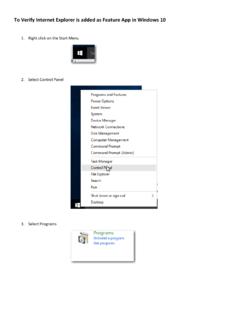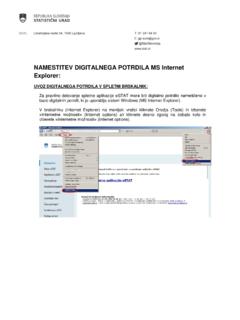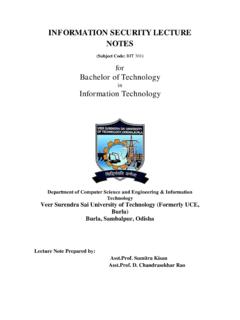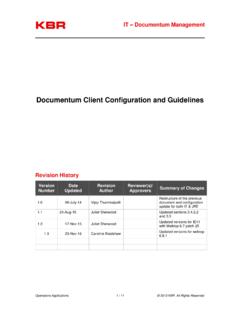Transcription of TCP/IP (Ethernet & Slip) Communications and …
1 ContentsSection I Introduction ..1 Section II Connecting via ethernet ..2 Configuring the for ethernet Communications ..2 Configuring Windows 2000/XP for ethernet Connection to ..3 Section III Configuring a slip Connection ..5 AccuLoad Settings for slip Communications ..5 PC Settings for slip Communications ..6 Section IV Using the TCP/IP Link ..8 Checking the TCP/IP Connection ..8 Section V Firmware Upgrade Procedure ..9 Upgrading the Firmware with the ..9 Procedure for Upgrading Firmware ..9 Troubleshooting ..13 Appendix Troubleshooting TCP/IP Communications ..14 Troubleshooting an ethernet Connection ..14 Troubleshooting a slip Connection ..14 Issue/Rev. (6/14) Bulletin AB06069 The Most Trusted Name In Measurement Application ManualTCP/IP ( ethernet & slip ) Communications and Upgrading FirmwareSmith Meter AccuLoad default or operating values used in this manual and in the program of the are for factory testing only and should not be construed as default or operating values for your metering system.
2 Each metering system is unique and each program parameter must be reviewed and programmed for that specific metering system Technologies Measurement Solutions, Inc. hereby disclaims any and all responsibility for damages, including but not limited to consequential damages, arising out of or related to the inputting of incorrect or improper program or default values entered in connection with the Smith Meter AccuLoad NoticeThis document contains information that is proprietary to FMC Technologies Measurement Solutions, Inc. and is available solely for customer information. The information herein shall not be duplicated, used, or disclosed without prior permission of FMC Technologies Measurement Technologies Measurement Solutions, Inc.
3 Will not be held responsible for loss of liquid or for damage of any kind or from any cause to the person or property of others, or for loss or profit, or loss of use, or any other special, incidental, or consequential damages caused by the use or misapplication of the contents stated (6/14)AB06069 Page 1 Section I IntroductionIntroduction to TCP/IP Communications and Basic NetworkingIt is not necessary to become a skilled network administrator to successfully communicate with the via TCP/IP . However, some basic networking knowledge will be quite helpful in establishing and maintaining reliable Communications with devices such as the that can be connected via ethernet and TCP/IP .
4 Some of the following terms may be encountered while configuring or maintaining your device connections: TCP/IP (Transfer Control Protocol/Internet Protocol) is the widely accepted standard protocol for Internet and World Wide Web Communications . Many other Internet standard protocols HTTP for Web browsing, FTP for file transfers, etc. use TCP/IP as the underlying control protocol. ethernet : A low-level protocol that implements the hardware link between two or more host devices. TCP/IP is often used over an ethernet connection. MAC Address: A fixed, permanent 6-byte hardware address assigned to an ethernet device by the manufacturer. IP Address: a four-byte (32 bit) number, usually displayed as 4 separate octets (8 bit numbers) , that uniquely identifies a host and network.
5 IP address ranges are grouped by class; the first few bits determine the class. Class A networks have a value from 0-127 in the first octet; class B networks start with 128-191; class C from 192-223. The special values of 224-239 are reserved for class D (multicast) addresses, and the values 244-255 are reserved (class E ) addresses. Net Mask: The number of bits in the IP address that are used to specify the network address. The remaining bits specify the host address. A Class C network has a net mask of 24 (the first 24 bits are common to all machines on the network, the last 8 bits are the host id and are unique for each machine on the network). Therefore, a class C network can have up to 254 hosts (host numbers 0 and 255 are reserved by the standard for special features such as broadcasting.)
6 A very large class A network has an 8 bit net mask leaving 24 bits to specify the host. Hence this type of network can have a huge number of host machines 224 = over 16 million computers but there can only be 255 of those types of networks in existence since there are only 255 unique network IDs that can be made from 8 bits. So why specify a net mask if it s implied by the network class? The reason for a net mask is clear when it is realized that some networks need to have many more hosts than 255, and that there would not be very many networks if we only allowed Class A networks. Net masks are often written out in octet is the same as saying the net mask is 24 bits.
7 It can also be specified with the network address using a backslash, So, if we have a machine on that network with the IP address (A class C network), the network address is and the host address is 23. There are some network addresses that are reserved by the standard as local network addresses. These network addresses are allowed only behind a router that hides the local network from the Internet. Many internal internet networks use these addresses: all the class C networks starting with and the class A network Since most organizations do not require a full class A network, often a subsection of the address space is used, This is called sub-netting.
8 Alternatively, sometimes two or more class C networks are combined thus: This is known as super-netting . Gateway: a gateway address specifies where outgoing messages addressed to other networks should be directed. This allows devices like routers, hubs and switches to be specified as the interface to anything external to the physical on TCP/IP and networking can be found on the World Wide Web. One example of a more detailed description can be found at This is one of an entire series of RFCs (Request For Comments) that make up the documentation on networking (6/14)Page 2 AB06069 Automation HostHubCorporate PCEthernetFirewallInternetPrinterCorpora te PCSection II Connecting via EthernetConfiguring the for ethernet Communications Power up the AccuLoad (wait for AccuLoad to complete initialization)
9 Press <Enter> at the Ready screen to access the Main Menu From the Main Menu, select Program Mode Menu and press <Enter> Enter the Access Code when prompted and press <Enter> From the Program Mode menu, select System Directory then Press <Enter> From the System Directory, select 700 Communications Directory Select Host Interface and press <Enter> From the Host Interface Menu set the following items: IP Address: Net mask: Gateway: ethernet Control: Poll and Program Comm Link: Level 3 Return to the Main Menu using the <Clear> keyNote: If using the s ethernet port, make sure that none of the serial Communications ports are configured to the slip ( TCP/IP ) function configuring a slip connection will disable the ethernet connection.
10 It is recommended that the be installed to a private network (not connected directly to the rest of the corporate LAN). This is best implemented by adding a second network interface card to the PC that will be interfaced to the AccuLoads. This dual-interface PC can be set up as a bridge allowing all the other PCs in the corporate environment to reach the AccuLoad devices (given permission to do so) but will prevent all other corporate LAN traffic from interfering with the (6/14)AB06069 Page 3 Section II Connecting via EthernetConfiguring Windows 2000/XP for ethernet Connection to : A Network Interface Card (NIC) installed in the PC and either: a CAT-5 crossover cable; or alternately two regular CAT-5 cables, and an ethernet hub/switch/router such as those manufactured by D-Link, LINKSYS, 3 Com, et.
